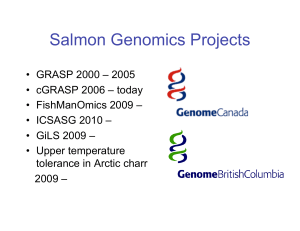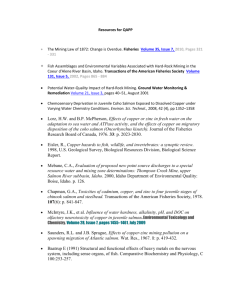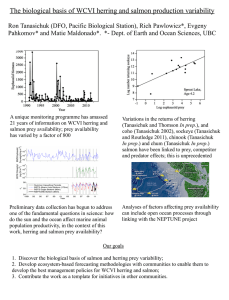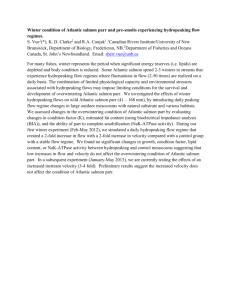ICES C.M. 1991 Progress and problems PAPER C.M. 1991/D: 1 Ref. Sess.U
advertisement
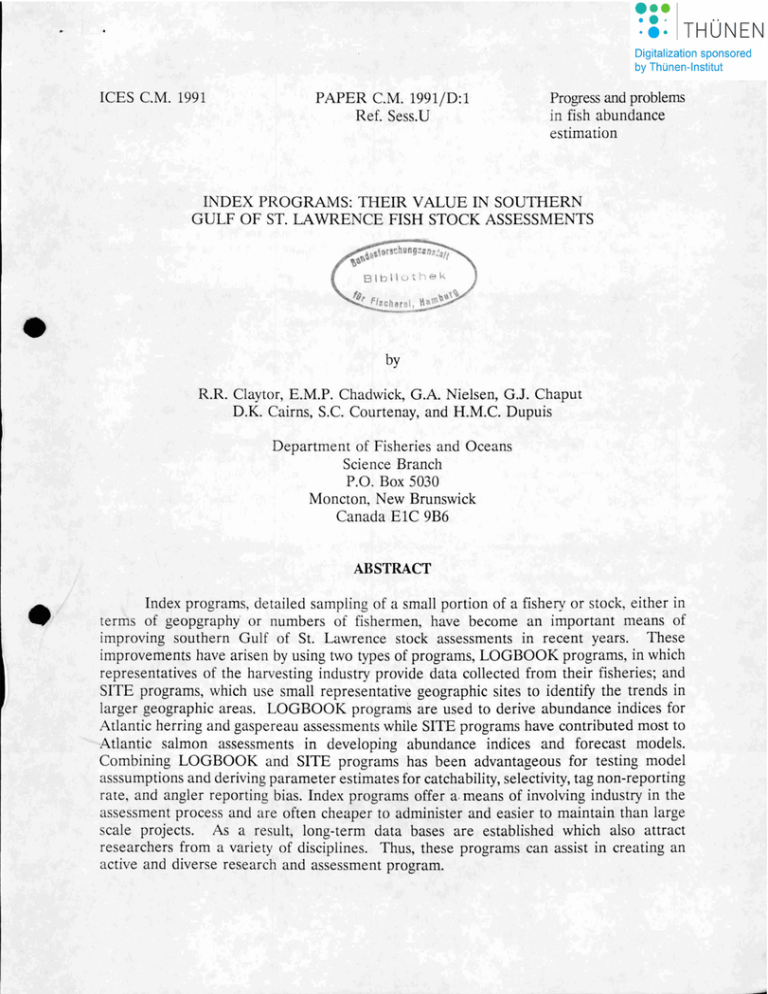
ICES C.M. 1991 PAPER C.M. 1991/D: 1 Ref. Sess.U Progress and problems in fish abundance estimation INDEX PROGRAMS: THEIR VALUE IN SOUTHERN GULF OF ST. LAWRE CE FISH STOCK ASSESSMENTS by R.R. Claytor, E.M.P. Chadwiek, G.A. Nielsen, G.J. Chaput D.K. Cairns, S.c. Courtenay, and H.M.C. Dupuis Department of Fisheries and Oeeans Seienee Braneh P.O. Box 5030 Moncton, New Brunswick Canada EIC 9B6 ABSTRACT Index programs, detailed sampling of a small portion of a fishery or stock either in terms of geopgraphy' or numbers of fishermen, have beeome an important means of improving southern Gulf of St. Lawrenee stock assessments in reeent years. These improvements have arisen by using two types of programs, LOGBOOK programs, in whieh representatives of the harvesting industry provide data colleeted from their fisheries; and SITE programs, which use small representative geographie sites to identify the trends in larger geographie areas. LOGBOOK programs are used to derive abundance indices for Atlantic herring and gaspereau assessments while SITE prograrns have eontributed most to Atlantic salmon assessments in developing abundance indices and forecast models. Combining LOGBOOK and SITE programs has been advantageous for testing model asssumptions and deriving parameter estimates for eatehability, seleetivity, tag non-reporting rate, and angler reporting bias. Index programs offer a· means of involving industry in the assessment proeess and are often cheaper to administer and easier to maintain than large seale projects. As a result, long-term data bases are established whieh also attraet researehers from a variety of disciplines. Thus, these programs can assist in ereating an aetive and diverse research and assessment program. -2INTRODUCTION In the southern Gulf of St. Lawrence, stock assessments are completed each year for one pelagic, Atlantic herring (Clupea harengus), and three anadromous species gaspereau (Alosa aestivalis) and (ß. pseudoharengus), and Atlantic salmon (Salmo salar). Each of these assessments prmides ad\ice on available harvest relative to a target level of flShing mortality, Fo.l , for herring and gaspereau, or expected numbers above a target escapement level, optimal spawning requirements for Atlantic salmon:lnitially these assessments may seem very different, however, the essential data and anal)tical requirements are similar. Each assessment requires that (1) a relative or absolute measure of abundance be derived and (2) the assumptions associated v.ith each model be tested. We have found that an efficient ~md cost-effective means'ofmeeting these requirements is to concentrate on sampling small representative portions of our flSheries or stocks in a detailed manner. This approach has lead to the development of index programs. This term should not be confused v.ith numerica1 indices that describe abundance or diversity but rather it refers to a specific type of research project. Index programs are best explained by example and we have established two types of these programs in the southern Gulf of St. La\\Tence. First, we havc those which involve representatives from the harvesting industry, for example, commercial gillnetters or recreational salmon anglers. These iridustry programs are used to answer specific questions regarding the fisheries involved and generally require participants to keep a logbook· of catches during the season or to answer questions about the fishery after the season has ended. We refer to these as LOGBOOK programs in the text. Second, we have established index sites which are representative of larger geopgraphical areas. These sites are used to collect data which are not" available through normal fishing activity, for example, flShing before or after regulated flSheries or using non-commercial gear to obtain more representative population sam pies. We refee. to these as SITE prograins in the text. Exclusively \\ith LOGBOOK, and as often as possible v.ith SITE programs we inmlve industry representatives in the data collection. This reduces the cost of research budgets and facilitates co-management of the resource by invohing government and industry directly in the assessment process. This paper prO\ides examples of how LOGBOOK and SITE programs have been incorporated into southern Gulf of St. Lm\TenCe assessment research and identifies areas we have targeted for improvement. We also hope to stimulate discussion v.ith other research groups emplo)ing these types of programs. Requests for· greater industry involvement in assessment and management procedures is increasing from v.ithin and outside government. As a result, these programs are going to become a more important part of assessment research and it \\ill be necessary to devclop models which efficiently incorporate these types of data. ASSESSl\IENT l\IODELS Asse<;,;r:~':' ::~ d pelagic species in the southern Gulf of St. La\\TenCe fall into two categories; (1) those used for Atlantic :'~:lllon and (2) those'used for herring and gaspereau. Atlantic salmon ad\ice is provided in terms of v.h~lhcr or not optimal spawning requirements have been met or if they are likely to be met in thc coming year. All salmon surplus to these requirements are considered available for harvest. Four parameters must be estimated: 1) removals, 2) spawning requirements, 3) spawning escapement, and 4) total returns one year in advance. Removals include landings from three types of fisheries, Native, commercial, and recreational, as weIl as removals resuIting from poaching and disease. Spawning iequirements are estimated from the total estimated juvenile rearing area in each rh'er. Spa\\ning escapement is determineü by subtracting removals from total returns.. Total returns are estimäteü using index traps, couriting fences; or fisheries exploitation rates. Forecasts of total returns depend on developing long time-series of data. Hence, the model is a simple one: •• -3(1) spa\ltning escapement=total returns-removals (2) available harvest=spa\ltning 'escapement-spa\ltning requirement and the status of the stock is judged with respect to spa\ltning escapement and spa\ltning requirement levels. In the Gulf of 51. La\ltTenCe we prO\ide this type of ad\ice for four major rh'ers on an annual basis (Chaput and Jones 1991; Chaput and Mullins 1991; Courtenay et a1. 1991; Moore et al. 1991) and for larger geographie areas as required (Cla}10r and .Mullins 1990; Mullins and Jones 1991). . • . Herring (Cla}10r et a1. 1990) and gaspereau (Chaput et a1. 1991) ad\iee is prO\ided in terms of a target fishing mortality, currently Fo.I ' Assessments generaIly use an age-structured model such as \irtual population analysis. The analysis is strengthened when it can be calibrated \ltith an abundance index. Two types of input data are required, eatch-at-age and one or more abundance indices. A procedure caIled ADAPT (Gavaris 1988) is used to calibrate the \irtual population analysis, rebuild the population, and estimate fishing mortalities. . Projections from the population matrix are used to prmide ad\ice for the coming year assuming various management options. LOGBOOK PROGRA:\IS Commercial catch-rates form the basis for abundanee indices in he~ring and gaspereau assessments. . Herring purchase slip data collected by Statistics Branch, Gulf Region prmide information about daily catches and the number of trips required to make that catch. These data are improved byconducting a telephone survey which determines the average number of nets used each year per gillnetter in the southern Gulf of 51. G\ltTence. • For this survey, a systematic random sampie of active gillnetters from aIl areas of the southern Gulf of S1. Lawrence is selected and tclephoned to obtain information that permits the follo\lting indices of effort and fishing acthity to be calculated: 1) the average number of net-hauls per gillnetter per season and day, 2) average length of net, and mesh sizes and numbers of nets fished for each mesh size, 3) the catch and percent of catch that was kept for bait, dumped, and sold to processors, and 4) a qualitative assessment of the gillnetters opinion on the abundance of herring in the eurrent year compared to pre\ious years (Nielsen 1991). Approximately 30% of the active 1200 herring gillnetters are surveyed each year during the two months (January-February) that the survey takes place. . There is also a program of index gillnetters, in which 2-6% of active gillnetters has participated. They prO\ide daily logbooks of their catch and effort and are asked for amounts caught, kept, dumped, sold, and used for bait, as weIl as, mesh-size, length of net, number of hauls and soak-time (Cla)10r et a1. 1990). Over one-third of index gillnetters have remained \ltith this program for five years. For both the spring and fall seasons, abundance indices are calculated from these catch-rates using a multiplicative model (Gavaris 1980) standardized for annual, area, and weekly effeets. Each of these herring abundance indices indicate the same general trend (Fig. 1). Thus, the smaIler set of index gillnetters, which is less costly to monitor, may become the principal abundance index when the time scries is long enough. A similar· program is also in place for the gaspereau trapnet fisheries and also provides additional information which is not on thc purchase slips, such as, number of traps, time spent fishing, and by-catch (Chaput et a1. 1991). This program also aIlows us to ohtain rCliahle abundance indices for smaIler fishing areas which would not normaIly receive any assessment attenti~n. . While these LOGBOOK programs produce improved abundance indices, theY\ltill also allow us to take into consideration faetors besides abundanee which may influenee catch-rales, such as; restrictions on fishing acthity imposed by markets, quotas, weckend closures, or differences in the fisheries (fishing on spmming -4grounds or migrating stocks) (Cairns et al. 1988; Nielsen 1991). SITE PROGRAMS . Forecasts arc an important part of ~ssessments becausc they allow managers to choosc among a variety of management options. Index SITES have been thc principal tool for developing forecast models in southern Gulf of St. Lawrence fisheries. Wc havc found that timing of herring, gaspereau, salmori, and smelt (Osmerus mordax) to· our various index sites (Fig. 2) has strong species arid area effects but weak year effects (Fig. 3). Thus, run-timing is a well-defined stock characteristie whieb cai:t bc used to assist in thc management of thesc species (Chadwick and Cla)10r 1989). . . On thc Miramiehi Rh'er, New Brunsv.ick, wc bavc operated an index SITE trapnet at Millbank (Fig. 2) sincc 1954. Tbis trap is located dov.nstream from all fisheries and because wc bave estimated thc efficiency of the trap, using mark-recapture, wc are able to obtain daily estimates of total numbers of salmon returning each year. Pre-season forecasts of mulli-sea-winter (MSW) salmon are made from one-sea-v.inter (ISW) salmon returns the previous year and in-season run-timing is used to updatc the pre-season forecast; The forecast model described above has been developed. following thc non-parameti-ic probability distribution models described by Noakcs (1989). Wc havc comapared this approach to parametric regression models on tbc Miramichi River data usingjackknifc (Cla)10r et al.1991) and Montc-CarIo simulation procedures (in preparation). In addition to reducing thc variance in pre-season forecasts this approach offers a flexible means of reporting the forecast uncertainty. For Miramichi salmon, the 1991 pre-season forecast indicates a 58% probability that target spav.ning requirements v.ill bc exceeded (Fig. 4). By induding run-timing information in thc model thc variance in the prc-season forecast is reduced by another 60% by mid-season (Fig. 4). Procedures \vhieh can combinc pre- and in-season information thus appear to prmide a powerful means of. imprming pelagic and anadromous assessments. Non-parametrie models. seem to have a.variety of applications in assessment research and may be a good procedure to investigate with other fisheries data. Unlike parametric techniques whieh requirc a variety of restrieth·c assumptions, such as normally-distributed errors; probability distribution models require no assumptions (Evans and Riec 1988; Riec and Evans 1988). Wc havc also used index SITES to estimate total returns and provide relativc abundancc estimates for two geographical areas in western Nev.foundland. Horne water returns for the Northern Penninsula in northwest Ncv.foundland (Fig.2) have bcen ca1culated using commcrcial and anglirig catch for thcse homewaters and adult rcturns to Wcstern Arm Brook (Chadv.ick 1983). Wcstcrn Arm Brook is an indcx SITE whcre completc counts of migrating smolts and adults have been obtained since 1971. Smolts migrating to sea and counted at Western Arm Brook arc thcn uscd to prcdict 1S\V salmon rcturns to. thc Northcrn Pcnninsula the ncxt ycar. This rclationship (Fig. 6) has bccn uscd to dctcrmine thc optimal spawning rcquircrricnts for Wcstcrn Arm Brook (Chadwick and Cla)10r 1990). . ,. -5Counts of adult returns at Fischells Brook and juvenile densities at Harrys Rh'er were used to assess the status ofwestern Ne\\foundland stocks in St. Georges Bay (Fig. 2). Significant correlations between Fischells Brook and Harrys River angling catches v.ith other St. Georges Bay rh'ers (Fig. 7) indicates that these two rh'ers are representative of relative trends in this area. In addition, the similarity in catch and run-timing between St. Georges Bay and Fischells Brook supports the conclusion that Fischells Brook represents the relative trends in these stocks (Fig. 8) (Cla)10r and Mullins 1990). ' CO;\IHINING LOGBOOK AND SITE PROGRAl\IS • Combining LOGBOOK and SITE programs prmides a powerful means of testing model assumptions and estimating parameters for assessment models. Atlantic salmon LOGBOOK and SITE programs have been used to obtain parameter estimates and test the follomng model assumptions: (1) that catchability does not change \\ith stock size, (2) the selecthity of gillnets, (3) non-reporting rate in a mark-recapture experiment, and (4) angler report relia,bility of kept versus released fish. The assumption that catchability does not change v.ith stock size was tested v.ith gillnetter LOGBOOK data from the Atlantic salmon fishery at St. Barbe Bay, Nev.foundland (homewaters for Western Arm Brook). A multiplicative model was used to calculate annual catch rates standardized for gillnetter and weck effects. These catch rates were compared to the abundance of the homewater stock counted at Western Arm Brook. We found that catchability did not change with stock size in this fishery. However, the year v.ith the highest abundance did not fit Ihis model. (Fig. 9) (Chad\\ick and Cla)10r 1990). Additional years of data from these LOGBOOK and SITE programs will enable us to determine the cause for this outlier. Data from the LOGBOOK and SITE programs at St. Barbe Bay and Western Arm Brook have also been used to study selecthity of salmon commercial gillnet fisheries. The fishery in Western Arm Brook is selective towards larger fish. The fork length of sahnon harvestcd in the commercial fishery was consistently 1-4 cm greater than those returning to the rh'er. In addition, the proportion of large salmon (<:: 63 cm) comprising the commercial catch exceeded the proportion of large salmon returningto the river (Fig. 9).. Hence, the mesh size of 127 mm used by the fishery appears to be remming most of the larger salmon, including repeat spa\\ners, from the spawning stock (Chad\\ick and Cla)10r 1990). The index SITES on the Miramichi River ha~'e been co~bined with an angling camp LOGBOOK program to estimate non-reporting rate of tags in the Miramichi Atlantic salmon angling fishery. Five angling camps provide us \\ith daily LOGBOOKS of catches and all tagged salmon caught. By comparing tagged to untagged ratios at the Millbank trap (below fisheries), and counting fences (above fisheries), to those re portcd by angling camps, we were able to estimate the non-reporting rate of tags and angling exploitation rate (Fig. 9) (Randall et al. 1990). Similarly, on the Margaree River, Nova Scotia (Fig. 2), by comparing angler LOGBOOK reports, population estimates from an index SITE, report cards which anglers complete and mail in after the season, and a creel survey, we were able to determine the relative accuracy of angler reports of kept versus released fish in the salmon angling fishery for that river (Fig. 9) (Cla)10r and O'Neil, in press). Quantification of this relative accuracy removed a large portion of the variability in the assessment of this stock. CONCLUSIONS AND IMPROVEI\IENTS Atlantic salmon assessments have provided a good model for demonstrating the utility of index programs in pelagic assessments. AIthough some may argue that herring, gaspereau, and salmon have little in common and that the salmon experience has little relevance to those assessing marine species, we argue that these specics and assessments have more similarities than differences. These species have severallife history traits in common, for example discrete spa\\ning sites, predictable run-timing, and repeat spav.ning. Thus, there are many ------------------------ -6opportunities for expanding these programs to marine speeies such as herring. For example, wc are now in the fourth year of dcveloping an abundance index from spawning bed surveys at Fisherrnens Bank, Prince Edward Island (Fig. 2). This SITE appears to have thc same potential for imprming herring as~cssments that we have found for Atlantic salmon SITES. . ~ ACKNOWLEDGEI\IENTS We thank thc many commereial gilltiettcrs and trapnctters, recreatiOlial anglers, and other members of thc fishing industry which have partieipated in our index programs. Tbe success of these programs would also n01 havc been possible without the exceIlent technical support provided by Department of Fisherics and Oceans field stafr. . . REFERENCES . ßlouw, D.M., S.D. Saxon, and E.M.P. Chad\\ick. 1988. Temporal variation of meristic traits \\ithin an Atlantic salmon (Salmo salar) stock, and implications for stock identification. Can. J. Fish. Aquat. Sei. 45:13301339. ' Cairns, D.K., E.M.P. Chad\\ick, and C. Bourque. 1988. Catch rates by index fishermen in the 4T herring fishery, ~98~-1987. Can. Tech. Rep. Fish.Aquat. Sei. No. 1660. Chadwick, E.M.P. 1983. Prediction' of 1SW Atlantic salmon returns in Statistical Area N, 1984. Canadian AtIantic Fisheries Seientific Advisory Committee Research Document 83/84: '(, Chadwick, E.M.P., and R.R. Claytor. 1989. Run timing of pelagic fishes in Gulf of St. Lawrence: area and ' speeies effects. J. Fish Biol. 35(Supplement A):215-223. Chadwick, E.M.P., and R.R. Cla}1or. 1990. Predictability in a small commercial Atlantic salnion flShery in western Ne\,foundland. Fisheries Research 10:15-27. Chaput, G., and R. Jones. 1991. Assessment of Atlantic salmon <Salmo salar) in the Margaree River, Nova Scotia 1990. ' Canadian Atlantic Fisheries Seientific Ad\isory Committee Research Document 91/3. ·7· Chaput, G., C. Leblanc, and G. Nielsen. 1991. Assessment of the Margaree Rh'er gaspereau fishery, 1990. Canridian Atlantic Fisheries Seientific Advisory Committee Research Document 91/12. Chaput, G., and C. Mullins. 1991. The status of the Atlantic salmon stock of Humber River/ Bay of Islands Nev.foundland. Canadian Atlantic Fisheries Scientific Adhisory Committee Research Document 91/14. Claytor, R.R, E.M.P. Chadwick, and H.M.C. Dupuis. 1990. Assessment of Atlantic herring in NAFO Division 4T, 1989. Canadian Atlantic Fisheries Seientific Advi~ory Committee Research Document 90/73. Cla)tor, RR, and C.C. Mullins. 1990. Status of Atlantic salmon stocks, Area K, Gulf Region, Nev.foundland 1989. Canadian Atlantic Fisheries Seientific Ad\isory Committee Research Document 90/16. Cla)tor, R.R., RG. RandalI, and GJ. Chaput. 1991. Forecasting preseason and inseason Atlantic salmon returns to the Miramichi Rh'er: Parametric and non-parametric approaches. Canadian Atlantic Fisheries Seientific Adhisory Committee Research Document 91/15. Cla)tor, RR., and S.F. O'Neil. in press. Using small creel surveys and mark-recapture experiments to interpret . angIing statistics. Trans. Am. Fish. Soc. 00:000-000. , Courtenay, S.C., G. Landry, A. Madden, and R Pickard. 1991. Status of Atlantic salmon in the Restigouche River in 1990. Canadian Atlantic Fisheries Scientific Advisory Committee Research Document 91/13. Cunjak, RA., E.M.P. Chadwick, and M. Shears. 1989. Downstrream movements and estuarine residence by Atlantic salmon parr (Salmo salar). Can. J. Fish. Aquat. Sei. 46:1466-1471. Evans, G.T., and J.C. Rice. 1988. Predicting recruitment from stock size v.ithout the mediation of a functional relation. J. Cons. int. Explor. Mer. 44:111-122. Gavaris, S. 1980. Use of multiplicative modelto estimate catch rate and effort from commereial data. Can. J. Fish. Aquat. Sei. 37:2272-2275. • Gavaris, S. 1988. An adaptive framework for the estimation of population size. Canadian Atlantic Fisheries . Seientific Advisory Committee Research Document 99/29. Moore, D.S., S. Courtenay, and P.R. Pickard. 1991. Status of Atlantic salmon in the Miramichi River during 1990., Canadian Atlantic Fisheries Seientific Ad\isory CommiUee Research Document 91/8. Mullins, C.C., and RA. Jones. 1991. Status of Atlantic salmon stocks, Gulf Region Nev.foundland and Labrador, 1990. Canadian Atlantic Fisheries Scientific Ad\isory Committee Research Document 91/10. Nielsen, G. 1991. The 1990 4T herring gillnet questionnaire. Canadian Atlantic Fisheries Ad\isory Committee Research Document 91/33. Noakes, DJ. 1989. A nonparametric approach to generating inseason forecasts of salmon returns. Can. J. Fish. Aquat. Sei. 46:2046-2055. RandalI, R.G., D.M. Moore, and P.R. Pickard. 1990. Status of Atlantic salmon in the Miramichi River during 1989. Canadian Atlantic Fisheries Seientific Ad\isory Committee Research Document 90/4. Rice, J.C., and G.T. Evans. 1988. Tools for embnieing uncertainty in the management of thc cod fishery of NAFO divisions 2J+3KL.. J. Cons. int. Explor. Mer. 45:73-81. -8- U"I"! 5,1AMl'lARDIJ[O Ultl RATU 'R,d~R~:~~~li~~~ lUX DE (PRIItU'$1 ,tOt .., ~ laU' .., : ~ 0 I \01 I 101 ~ i I o 78 11 .. 0 11 11 B) 101 - a~ ... n LI 11 1& g~ 10 71 11 " Il Ja. B 3'J U " " 'I 10 lI:.u TlU S.RI .. I S1UOIIIOII[0 tA,TCI IlUES rUl HUURflZU CA1CH UH\ lAUX Ir 'RIS~'sTVATuTfJi.\ • 11 IAUX .0IMUIUS 'RllrS"'~R\Tll'Nts O[ lIRlITWSI Z>I 100 ::: \00 ~ ~ ~oo :1 _ 100 § '00 ;i 100 I -l,.----r-.----.-,.---,----,-,-----r-,--.--,.-, TI ,. 11 .0 " 11 .l 'I I. 16 11 .B B9 11 U ., 11 IJ " r All SIRIM' 11Q~IARIII~t Vlll~ lAUX ,r , I~ ~ ~ bY~u ll~ n eH U 11 IQ • ilA'R~9"~P f~W um IAUX O[ 'R IIsxlaA~h\~IS flRlmmt IA l[l iOIUlIS[\ HI 1/01 1001 ~ tj 1801 = '"~ : JOt 1801 5'U ~ 140' ~ 1101 ~ tODI ~2M ;IU ~ '01 ~ U I[U IIAR i 801 '01 ZOO IU 1I I T8 71 40 " ., 8) 11 11) &1 .sl III 19 9P n 11 &1 t1 11 IJ HU U 11) n BI U 11 10 I[U Fig. 1. Cateh-rate indices derived for fall (left) and spr~ng (right) sourthern Gulf of St. Lawrenee herring fisheries from purehase slips (top), gillnetter telephone survey (middle), and index gillnetters (bottom). -9- • • • Gulf of St. Lawrence index SITES * Fig. 2. Index SITES in southern Gulf of St. Lawrence used in herring, gasperereau, and Atlantic salmon assessments. SITES designated DFO are run by the Department of Fisheries and Oceans. CEIC, Canada ~lanpower and Emigration; PC, Parks Canada; DNRE, New Bruns,;ick Department of Natural Resources and Energy; SPAWN, Salmon Preservation Association for the Waters of Newfoundland. Those indicated by a * are mentioned in the text. SLtes 10-14 are index SITES for the Miramichi River. * * * * * * * * * 1. 2. 3. 4. S. 6. 7. 8. 9. 10. 11. 12. 13. 14. 15. 16. 17. 18. 19. 20. 21. Yestern Arm Brook, DFO Torrent River, DFO Bound Brook, GEIG North Brook, CEIG Hughes Broak, GEIG Humber, OFO Lake O'Law, OFO More11 River, OFO Black River, PG Bartho1omew River, ONRE North Branch'SY Miramichi River, DNRE Oungarvon River, ONRE Mi1lbank Trap, OFO NY Miramichi, DNRE Gatamaran Brook, OFO Nepisiguit River, GEIe Upsa1quitch River, DNRE Harrys River, DFO Fischells Brook, SPAWN Margaree River, DFO Fishermens Bank, DFO EARLY EARLY --- mr -- aR[ J &1 B6 B5 SI GEDR "" c>: SJ >- BI « w w '"'"'" mr -.- .. 11 RA CHH ----------- SiltMON AlEWIFE -+ -- ...... -... ....- -- BI -- I ...... 0 I SO ------150 135 ...- 78 ....- 135 160 -----.1 I 160 lULIAN DA! Fig. 3. 79 'I 'I 125 Sf.4ELT HERRING SiltMON AlEWIFE Sf.4El.J HEARING I J5 200 225 120 140 160 150 1(0 160 17 D 190 210 230 JULIAN DAY Variation in early (spring and summer) run timing of alewife, herring, salmon, and smelt in six areas (left) and ten years (right) in the southern Gulf of St. Lawrence. Newfoundland; BRET, NWNF, northwest Cape Breton; GEOR; St. Georges Bay, Newfoundland; SWGF, southwest Gu f; MlRA, Miramichi; CRAL, Chaleur Bay. -11O. J Z 0.28 = = ,""" ...... 0.24 ....... = 0,20 ...... = >- O. 16 ,...... --J • = -:: O. 12 0.. o.08 = = 0:: 004 0.00 0 10 20 30 ~o 50 60 70 80 90 100 29 30 3I 32 MSW RETURNS X 1000 1. 4 1 2 1.0 ....... <:.-:> = -:: 0.8 = 0.6 - :: ::- 0.4 0 2 0.0 IN 23 H 25 26 27 2B STANDARDIZED WEEK Fig. 4. Probability distribution (top) of pre-season forecast for Miramichi River salmon. The vertical line represents spawning requirements. The sum of the probabilities to the right of the line indicates a 58% probability of exceeding requirements. Reduction in variance from pre-season model (IN) by including inseason information is shown in the bottom figure. lSW salmon MSW salrnon ~lrQAIChl Mir ani t h i 100000 40000 90000 60000 ~ 30 D00 ~ c / c 70000 - 60000 - / ~ ~ ~ . u :: 20000 "c; - / 40000 ~ z: ~ u 10000 J 000 0 ( 22 / _ r"- 0 40 J6 J1 30 24 20 42 , / j ?/ 10000 -.- / / 70000- 10 .--- 50000 22 24 _0" 26 I 26 }O J2 J4 J6 JB 40 42 Waal Wlak Northwest Miramichi Northwest Miramichi lSW Salnon IASW Salman 1400 350 1200 300 ~ :: ::; 250 1000 ~ -;; ~ 200 - BOO -;;; 600 :: . -; 150 ~ ~ ~ 400 200 50 24 26 28 30 J7 36 38 40 42 Week . VI] e k • • ) Fig. 5. Total returns ot Atlantic salmon to Millbank index trap ( top compared to a site upstream from all fisheries on the Miramichi River (bottam) for multi-sea-winter (MSW) salmon (left) and one-sea-winter (lSW) (right). >--' N I HOOO 27000 • 25000 -t- ... 23000 >- 21000 0 <U = 0 <U -e c: ::> <U = "" 19000 17000 • 15000 • • I JODD • I •• • 9000 • • 7000 • •• 5000 5000 9000 Western Arm Fig. 6. W • • 11000 Q ......I • 13000 Broo~ 17000 Z1000 Smol ts rear Relationship between smolts counted at Western Arm Brook index SITE and total returns to western Newfoundland, Northern Penninsula, (Area N). -14- mo 90GO 8~OO SOGO 1100 10~0 6040 ;k '"-5010 " ~ IO~O Y,' < « , mo • ~ ........ :- . lOGO ... "'t. I 20~0 10~0 -'. m .' zm mo 1040 / ::> . • ::> .. :;: -' . . )OM • IO~O , I .... noo • ~ 15~0 I ~ l~OO mo 150~ 1000 HHrJl Ri Hr ISW mo ~ 1~00 ....... J ... ". .. 510 fi lchli Is Bmk ,,. .. ",' I , ," rilchlll5 Bmk m Fig. 7. HIlfJl Ri ,er m Regression lines (solid lines) and 95% confidence limits für the mean für relatianships between Fischells Braak, Harrys River, and ather St. Geürges Bay, Newfaundland, (Area K) rivers. Canfidence limits are shawn by dotted lines. Area K Area K rISHERY=R FISHERY=R H=I IP=I 2DO 1200 17~ 1000 .. ~ 150 0= ~ ..•.. '" :z :z ...., -800 :::; 125 ;; c :; 600 . '" 100 In _ iOD 200 .....I \Jl o 2<J 21 22 2 ~ 2i 25 26 27 2 B 29 30 31 32 33 H ~~ J6 37 20 21 38 22 23 H 25 26 27 28 29 3D 31 32 ~3 :H 35 3E; 37 3B W[[K wEEK MSW FISCHELLS ANGLING 1SW FISCHELLS ANGLING TP-I lP·l 16 14 ... = .... a .. '"... .. 40 ~ 12 .<> 10 c .. ..'" V> _ 20 .., 6 -' "" 10 2 2D 21 22 23 24 25 26 27 28 29 30 3I 32 33 34 35 36 31 38 WEEK 20 21 22 23 H 25 26 27 28 29 30 31 32 J1 34 15 36 37 38 WEEK Fig. 8. Mean numbers of small (left) and large (right) salmon caught each week during the recreational Atlantic salmon season in St. Georges Bay, Newfoundland (Area K) rivers (top) and Fischells Brook (bottom). I , .... -16- • + 0.03 ~ I J ~ Q) >- ~ Ci) 0.02 =. .c Cf) i.L "".' ~ 0.Q1 U • I1I1I1 tr • ~ Cl) E E o o ü • 10,000 12,000 14,000 16,000 18,000 20,000 22,000 Western Arm Braak Smalts Year i 1.2 7 0 :.;:; 1 6 ~ CI: l:J 0.8 0 .;::; 0) 0) ~ 0.6 .... er: Q) 5 ro ~ 4 Cf) C ~ 3: ::> .. 3 Cf) l:J ~ Q) 0.4 0) 0) 2 ~ ~0.2 o o Fence Angling All Camp Anglers TRAP LOG CREEL DFO Fall 87 L1C TRAP- LOG CREEL L1C DFO Fall 88 Fig. 9. Standardized commercial catch-rate ~n year i+1 against smolts leaving leaving Western Arm Brook in year i (top left). Percentage of large salmon in total commercial catch compared with percentage of large salmon returns counted at Western Arm Brook (top right). Tagged:untagged ratio of Atlantic salmon obtained from counting fences (SITES), angling camp (LOGBOOK), and all anglers on the Miramichi River (bottom left). Multi-sea-winter (MSW):one-sea-winter(lSW) ratios from index SITE (TRAP), LOGBOOK (LOG), creel (CREEL), fisheries officer (DFO), and angler license returns (Lle) on the Margaree River. ,.~

